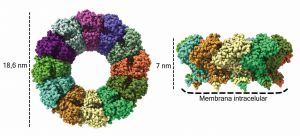Reguera, investigador responsable del proyecto, destaca, “los poros controlan el acceso a los orgánulos de replicación viral y aseguran el etiquetado del ARN en su camino hacia el citoplasma celular. La estructura revela con un detalle sin precedentes los mecanismos de unión de las membranas, el ensamblaje de las proteínas y cómo esto activa el proceso que conduce al camuflaje del ARN en estos virus de ARN”.
Los investigadores han observado que la proteína nsP1 sólo es activa cuando se ensambla en las membranas celulares. "Este mecanismo regulador permite a la proteína hacer el trabajo correcto en el lugar adecuado. Esta estructura redefine los complejos de replicación del virus Chikungunya como verdaderos reactores, en principio capaces de procesar simultáneamente hasta doce moléculas de ARN, lo que podría explicar la alta infectividad de estos virus. Si encontramos la forma de evitar la formación de estos complejos con pequeñas moléculas que interfieran, podríamos impedir su proliferación”. “Supongo que para los coronavirus, que también llevan a cabo la replicación y el camuflaje de sus ARNs en orgánulos membranosos, esto podría ser bastante similar", recalca Reguera. El alto grado de los detalles atómicos de la estructura obtenida puede ciertamente conducir al diseño de moléculas con capacidad terapéutica. Los antivirales actuales están diseñados para proteínas individuales o pequeños complejos, y la determinación de esta estructura permite ahora el análisis de estos antivirales en el contexto fisiológico real de la proteína asociada a las membranas durante la infección.
Red Mediterránea de estudios de criomicroscopía electrónica
El CNB-CSIC es uno de los pocos centros del sur de Europa que posee la última tecnología de criomicroscopía electrónica. Por este motivo, varios grupos de investigación de Marsella han establecido una "Red mediterránea para el estudio de la criomicroscopía electrónica" con el Centro Nacional de Biotecnología (CNB-CSIC) en Madrid. "Esta colaboración ha sido fundamental para la obtención de estos resultados, y somos muy afortunados de haber tenido acceso a equipos de última generación en España" dijo la investigadora Rhian Jones, participante en el trabajo.
Rocío Arranz, responsable del Servicio de criomicroscopía electrónica en el CNB-CSIC, valora positivamente la colaboración y la obtención de resultados, que demuestran que las inversiones del Ministerio de Ciencia e Innovación y el CSIC en las infraestructuras del centro “sirven para proporcionar el mejor equipo y experiencia técnica a nuestros colaboradores y usuarios para alcanzar los más altos estándares científicos"
Más información:
Nota de prensa CSIC-Comunicación
Referencia Bibliográfica
Capping pores of alphavirus nsP1 gate membranous viral replication factories
R Jones, G Bragagnolo, R Arranz, J Reguera. Nature 16 Dec 2020, DOI: 10.1038/s41586-020-3036-8






